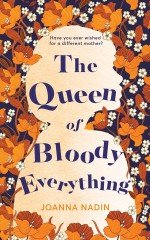ER Summer Reads: The Queen of Bloody Everything
by Celeste PanAn author’s transition from children’s books to adult fiction cannot but arouse the suspicion that outgrowing a genre requires time. In other words, the initial attempts are almost inevitably hybrids, haunted by traces of fairy tales, toy monkeys and misplaced innocence. Joanna Nadin’s The Queen of Bloody Everything offers, if not a refutation, then a formidable self-justification which uses the accusation to her own advantage.
Nadin’s stylistic maturation is conjoined seamlessly with the coming-of-age (in the broadest possible sense of the word) of Dido Jones, recounted by herself at her mother Edie’s deathbed. The result is a hypnotically original and convincing voice, weaving deftly between past and present. There is a sustained tension between the presentation of the narrative as a monologue and its bewitching frankness that tempts the reader, time and again, to take it for the only version of truth.
Dido’s reminiscence begins with the mother-daughter duo’s encounter with their new neighbour in Saffron Walden, the Trevelyans, in the 1970s, and ends on a somewhat symmetrical note thirty years later. It maps the history of two families, along with the inexplicable forces of fascination and repulsion they exert over one another. The portion dealing with Dido’s childhood shines with a particular brilliance, with its riot of colour, taste, heat and unwitting swearing, all serving as the backdrop for the unfolding character of Edie, Dido’s anarchist, seductive and reckless whirlwind of a mother.
As Dido enters adolescence, there is a noticeable shift of tone and texture towards vertigo and disillusionment as her girlish optimism becomes constantly thwarted. Much like clouds thickening before a storm, the bleakness of the intervening years anticipates the explosion and eclaircissement in the fateful winter of 1987. What follows has a posthumous aura, and is in a different key altogether: the child’s voice has died away completely, and the adult Dido has much to rediscover, regain and redeem.
Nadin’s writing distinguishes itself most of all with its unassuming erudition, shimmering through her well-placed and highly accessible references to literature, art and politics. This, together with a heightened immediacy of time and place, calls to mind a modernised and more vibrant version of George Eliot. In much the same way, her syntax balance sophistication with a remarkably natural poise. Some sentences, Circe-fashion, demand to a lingering attention before the reader is allowed to read on. It is not for those who merely desire an easy read; yet it will more than do the job for someone who is willing to be uplifted, crushed, tickled and driven to tears by the sheer vibrancy, momentum and magnitude of a life in every way as ordinary as their own.
One can hardly avoid falling into cliché when attempting to define what it means to be a ‘queen of bloody everything’ in the modern world; indeed emancipation and sovereignty over one’s own body are essential ingredients, yet the author sees queenship as much more than that. At the heart of Edie’s and Dido’s daily majesty is an infinite potential for forgiveness, imagination and survival, even after the rejection of an Aeneas—which exalts them over their classical prototypes, Cleopatra and, for that matter, the Carthaginian queen herself. Dido Jones transforms Tennyson as she demonstrates that better than ‘to have loved and lost’ is to have lost and love on—to the extent that the self ceases to be, to the extent that the self becomes sublime.
…And there is always hope.
 Joanna Nadin, The Queen of Bloody Everything, Mantle, 405 pp, available in hardback and trade paperback £12.99, Ebook £11.99
Joanna Nadin, The Queen of Bloody Everything, Mantle, 405 pp, available in hardback and trade paperback £12.99, Ebook £11.99

